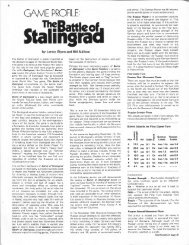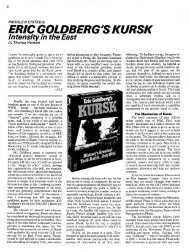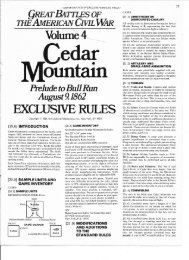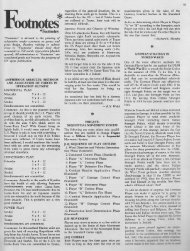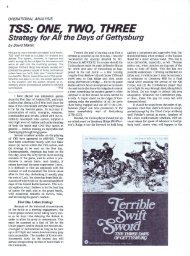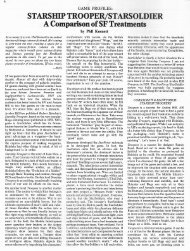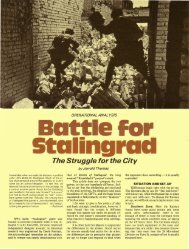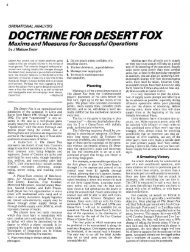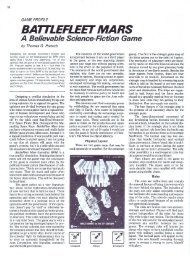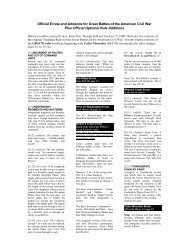Napoleon At Waterloo - Learning SPI's Great Battles of the American ...
Napoleon At Waterloo - Learning SPI's Great Battles of the American ...
Napoleon At Waterloo - Learning SPI's Great Battles of the American ...
Create successful ePaper yourself
Turn your PDF publications into a flip-book with our unique Google optimized e-Paper software.
24<br />
Grouchy at <strong>Waterloo</strong> by<br />
A.A. No!;<br />
Marshal Grouchy is one <strong>of</strong> <strong>the</strong> people in<br />
history who have assumed <strong>the</strong> role <strong>of</strong><br />
scapegoat over <strong>the</strong> years. Historians <strong>of</strong> <strong>the</strong><br />
<strong>Waterloo</strong> Campaign place much <strong>of</strong> <strong>the</strong> blame<br />
for <strong>Napoleon</strong>'s defeat at <strong>Waterloo</strong> on his<br />
shoulders. The refrain goes something like, "If<br />
Grouchy had brought his troops to <strong>the</strong> support<br />
<strong>of</strong> <strong>Napoleon</strong> at <strong>Waterloo</strong> <strong>the</strong> outcome <strong>of</strong> <strong>the</strong><br />
battle would have been changed." Perhaps. But<br />
one thing is clear: few <strong>of</strong> <strong>the</strong> works on <strong>the</strong><br />
Battle <strong>of</strong> <strong>Waterloo</strong> ever bo<strong>the</strong>r to detail what h<br />
was that Grouchy was actually doing those<br />
fateful June days.<br />
The <strong>Waterloo</strong> Campaign opened on 15 June<br />
1815 when <strong>the</strong> first French troops began<br />
•<br />
crossing <strong>the</strong> Sambre against sharp resistence<br />
from minor Prussian formations. Since<br />
<strong>Napoleon</strong> had "stolen a march" on both <strong>the</strong><br />
Prussians and <strong>the</strong>ir Allies his army managed to<br />
get across in relatively good order and slept on<br />
<strong>the</strong> field <strong>the</strong> night <strong>of</strong> 15·16 June. That night<br />
Blucher, <strong>the</strong> Prussian commander, and<br />
Wellington, <strong>the</strong> Anglo-Allied commander, had<br />
<strong>the</strong>ir exhausted troops marching as best <strong>the</strong>y<br />
could toward <strong>the</strong> French. [Note: In this article<br />
Prussian formations will be in italics for<br />
claritv.l<br />
On 16 June two battles occured, one at Quatre<br />
Bras and one a few miles to <strong>the</strong> east at Llqnv,<br />
<strong>At</strong> Ouatre Bras <strong>the</strong> outcome was basically a<br />
draw, with <strong>the</strong> Anglo-Allied forces left in<br />
possession <strong>of</strong> <strong>the</strong> field largely through French<br />
ineptitude. l.lqnv. however, was a decisive<br />
action. Nearly two-thirds <strong>of</strong> <strong>the</strong> Prussian army<br />
'under' Blucher, were soundly beaten, suffering<br />
about 30,000 casualties out <strong>of</strong> a force <strong>of</strong> no<br />
more than 85,000.<br />
The broken, roadless terrain about Llqnv ,<br />
coupled with <strong>the</strong> lateness <strong>of</strong> <strong>the</strong> hour<br />
prevented an effective pursuit <strong>of</strong> <strong>the</strong> Prussians.<br />
Still, <strong>Napoleon</strong> sent I Cavalry Corps scouting<br />
nor<strong>the</strong>ast toward Namur along <strong>the</strong> Prussian<br />
line <strong>of</strong> communication. II Cavalry Corps was<br />
instructed to scout in <strong>the</strong> general direction <strong>of</strong><br />
Gembloux, a possible alternative line <strong>of</strong><br />
communication for <strong>the</strong> Prussians and a small<br />
force <strong>of</strong> cavalry was sent <strong>of</strong>f toward Tilly to<br />
try to determ ine whe<strong>the</strong>r <strong>the</strong> Prussians had<br />
fallen back that way.<br />
The respite given <strong>the</strong>m by nightfall enabled <strong>the</strong><br />
Prussians to recover <strong>the</strong>ir strength and<br />
cohesion somewhat. Blucher's chief <strong>of</strong> staff<br />
ordered <strong>the</strong> remnants <strong>of</strong> , and /I Corps (C.<br />
30,000 men) to withdraw towards Tilly while<br />
"' Corps (c. 20,000 men) was to retreat<br />
towards Gembloux. Meanwhile, Bulow's 'V<br />
Corps (c. 30,000 men and 88 guns) was<br />
marching up from Liege. This corps was <strong>the</strong><br />
only undamaged element in <strong>the</strong> Prussian<br />
Army, having missed <strong>the</strong> Battle <strong>of</strong> l.lqnv. Early<br />
on 17 June <strong>the</strong> lead elements <strong>of</strong> 'V Corps<br />
linked up with "' Corps.<br />
Bulow assumed command <strong>of</strong> /I, Corps and<br />
marched both formations towards Wavre on<br />
his own initiative. <strong>At</strong> 1020 this move was<br />
confirmed by Blucher. This was probably <strong>the</strong><br />
single most important strategic decision made<br />
by <strong>the</strong> Allies in <strong>the</strong> <strong>Waterloo</strong> Campaign.<br />
By retreating towards Wavre, Blucher abandoned<br />
his line <strong>of</strong> comrnunication, cutting his ties<br />
with his b~se at Liege and his line <strong>of</strong> retreat<br />
back into Prussia. Though badlv defeated, <strong>the</strong><br />
semi-senile, septuagenarian Blucher was willing<br />
to have ano<strong>the</strong>r go at <strong>Napoleon</strong> ra<strong>the</strong>r than<br />
quit. By this decision he completely altered<br />
<strong>the</strong> strategic situation.<br />
While Blucher was retreating, <strong>the</strong> French<br />
cavalry was beginning to report to <strong>Napoleon</strong>.<br />
All reports seemed to indicate that <strong>the</strong><br />
Prussians were broken and falling back towards<br />
Prussia. The thousands <strong>of</strong> straggling troops<br />
jamming <strong>the</strong> roads towards Prussia seemed to<br />
confirm this conclusion and <strong>Napoleon</strong> <strong>the</strong>refore<br />
assumed it was true. To ensure <strong>the</strong> defeat<br />
<strong>of</strong> <strong>the</strong> Prussians he entrusted some 33,000<br />
troops to Marshal Grouchy and ordered him to<br />
maintain a strong pursuit but to retain his<br />
freedom <strong>of</strong> movement. Since word from<br />
Quatre Bras indicated that <strong>the</strong> situation <strong>the</strong>re<br />
was still inconclusive, <strong>Napoleon</strong> took <strong>the</strong><br />
balance <strong>of</strong> his Right Wing with him-although<br />
inexplicably leaving one full division at St.<br />
Amand and marched to Ouatre Bras. Grouchy<br />
was on his own.<br />
There were heavy rains all that day and <strong>the</strong>se,<br />
combined with poor staff work resulted in <strong>the</strong><br />
gradual loss <strong>of</strong> contact between Grouchy's<br />
cavalry patrols and <strong>the</strong> retreating Prussians.<br />
<strong>At</strong>tempts to re-establish contact were frustrated<br />
by <strong>the</strong> wea<strong>the</strong>r and by 1900 Grouchy qave<br />
up and bedded his troops down in <strong>the</strong> vicinity<br />
<strong>of</strong> Gembloux. Here he conveyed to <strong>Napoleon</strong><br />
incorrect reports from his scouts that <strong>the</strong><br />
Prussians had broken into two columns, one<br />
falling back on Liege and <strong>the</strong> o<strong>the</strong>r on Wavre.<br />
He indicated that he would pursue <strong>the</strong> larger,<br />
which appeared to be headed for Wavre. This<br />
evaluation <strong>of</strong> <strong>the</strong> situation was completely<br />
wrong. The' entire Prussian Army was falling<br />
back on Wavre. The troops seen heading for<br />
Liege were a large, disordered mass <strong>of</strong><br />
stragglers. The situation was serious since <strong>the</strong><br />
Prussians were reconcentrating but <strong>the</strong> French<br />
didn't know it.<br />
Blucher reached Wavre with most <strong>of</strong> his army<br />
<strong>the</strong> night <strong>of</strong> 17-18 June, while Grouchy's<br />
troops slept. Early <strong>the</strong> next morning he<br />
ordered his forces, by now numbering around<br />
80,000 men, to join Wellington's forces in <strong>the</strong><br />
vicinity <strong>of</strong> Mont-St.-Jean. The march was late<br />
in getting started because a massive traffic jam<br />
ensued which took hours to clear up.<br />
Grouchy, meanwhile, delayed his morning<br />
orders and did not finally move out until<br />
0730. With II Caval ry Corps scouting ahead<br />
and I Cavalry Corps covering his left and<br />
attempting to link up with <strong>Napoleon</strong> and <strong>the</strong><br />
main body, he advanced on Wavre with his two<br />
infantry corps. Some historians have stated<br />
that <strong>Napoleon</strong> ordered Grouchy on this<br />
morning to fallon Wellington's flank if <strong>the</strong><br />
opportunity presented itself. While <strong>the</strong>re exists<br />
no evidence substantiating this order, it is<br />
reasonable to assume that, if it was issued,<br />
<strong>Napoleon</strong> expected Grouchy to recognize that<br />
his primary mission was to keep between<br />
Blucher and Wellington at all times. But this is<br />
precisely what Grouchy failed to do.<br />
Advancing carefully but agressively Grouchy's<br />
cavalry encountered and skirmished for about<br />
an hour with elements <strong>of</strong> Prussian /I Corps<br />
below Wavre beginning about 0930. Prisoners<br />
revealed that Blucher was sending <strong>the</strong> bulk <strong>of</strong><br />
<strong>the</strong> Prussian Army to join Wellington, and <strong>the</strong><br />
commander <strong>of</strong> II Cavalry Corps lrnmedlatelv<br />
dispatched this unpleasant information to<br />
Grouchy. By this time Grouchy had reached<br />
The terloo Campaign Key:<br />
I......J Prussian and Allied Positions,<br />
;1600, 18 June 1815<br />
-+ French Movements, 16-18 June<br />
o French Positions, 16 June
25<br />
Walhain with III Corps and IV Corps was just a<br />
little behind. Settling down for lunch, <strong>the</strong><br />
Marshal's mess was disturbed at 1130 by <strong>the</strong><br />
sound <strong>of</strong> artillery fire coming from <strong>the</strong><br />
direction <strong>of</strong> Mont-St.-Jean, about a dozen<br />
miles to <strong>the</strong> northwest. The commander <strong>of</strong> IV<br />
Corps and several o<strong>the</strong>r senior <strong>of</strong>ficers<br />
demanded that Grouchy immediately move to<br />
support <strong>Napoleon</strong>, who was obviously engaged<br />
in a major battle. Grouchy refused, pointing<br />
out that his orders required him to pursue <strong>the</strong><br />
Prussians. Had he moved at this point he<br />
would probably have arrived on <strong>Napoleon</strong>'s<br />
right flank about 1900 hours, just in time to<br />
fallon <strong>the</strong> Prussian IV Corps as it engaged<br />
<strong>Napoleon</strong>'s troops near Placenolt and also in<br />
time to support <strong>the</strong> attack <strong>of</strong> <strong>the</strong> Old Guard.<br />
Undoubtedly, Grouchy could have influenced<br />
<strong>the</strong> course <strong>of</strong> <strong>the</strong> battle, but it is not<br />
necessarily <strong>the</strong> case that his arrival would have<br />
turned <strong>Waterloo</strong> into a French victory. The<br />
luncheon went on, only to be interrupted<br />
again at 1230 when <strong>the</strong> messenger from II<br />
Cavalry Corps finally arrived, having taken two<br />
hours to cover about six miles. He told<br />
Grouchy that <strong>the</strong> Prussians were preparing to<br />
fallon <strong>Napoleon</strong>'s flank.<br />
Grouchy immediately, and belatedly, moved<br />
into action. I Cavalry Corps was ordered to<br />
take <strong>the</strong> village <strong>of</strong> Limale followed by IV<br />
Corps, while III Corps marched for Wav're<br />
screened by II Caval ry Corps.<br />
Holding <strong>the</strong> Iine <strong>of</strong> <strong>the</strong> Dyle River, between<br />
Limale and Wavre, was Prussian III Corps (c.<br />
17,000). Fighting began at 1630, when II<br />
Cavalry Corps arrived in front on Wavre,<br />
closely followed by III Corps. The French<br />
cleared <strong>the</strong> nearslde <strong>of</strong> <strong>the</strong> river handily but<br />
got into a difficult position doing so. From <strong>the</strong><br />
heights <strong>of</strong> <strong>the</strong> left bank Prussian batteries sh ot<br />
up <strong>the</strong> French badly. Although <strong>the</strong> Prussian<br />
defense was improvised it was highly effective.<br />
Ironically if <strong>the</strong> French had delayed a bit<br />
longer <strong>the</strong> Prussians would have been out <strong>of</strong><br />
<strong>the</strong> position entirely, marching for <strong>Waterloo</strong>.<br />
Indeed, one brigade had already marched <strong>of</strong>f,<br />
but had been replaced by a wayward brigade<br />
<strong>of</strong> I Corps which took up position in Limale.<br />
Meanwhile, Blucher, by this time closer to<br />
<strong>Waterloo</strong> than to <strong>the</strong> action at Wavre, had a<br />
difficult time convincing his <strong>of</strong>ficers to<br />
continue to march to support Wellington.<br />
Fortunately for <strong>the</strong> Allies, he was successful.<br />
Unlike Grouchy, Blucher recognized what his<br />
primary mission was and did not permit<br />
secondary considerations to influence his<br />
judgement. Defeating <strong>Napoleon</strong> was far more<br />
important than <strong>the</strong> fate <strong>of</strong> one corps at Wavre.<br />
hi le Blucher was making this decision, <strong>the</strong><br />
situation along <strong>the</strong> Dyle grew heated and<br />
bloody. In a short time I and II Cavalry Corps<br />
and III Corps were hotly engaged and IV Corps<br />
vas moving up rapidly, though because <strong>of</strong> a<br />
confusion in orders it was turning up at Wavre<br />
ra<strong>the</strong>r than Limale. <strong>At</strong> 1700 Grouchy finally<br />
received orders from <strong>Napoleon</strong> to assist <strong>the</strong><br />
main body at <strong>Waterloo</strong>. Ordering III Corps and<br />
II Caval ry Corps to keep up <strong>the</strong> pressu re at<br />
Vavre, Grouchy assembled IV Corps and<br />
marched for Limale, but not before wasting<br />
more time by making one final attempt to take<br />
Vavre.<br />
t Limale I Cavalry Corps, supported by a<br />
cavalry division from IV Corps, had just<br />
9JCeeded in siezing <strong>the</strong> village at <strong>the</strong> charge<br />
'<strong>the</strong>n Grouchy arrived with <strong>the</strong> balance <strong>of</strong> IV<br />
Corps. The Prussians made a serious effort to<br />
ratake <strong>the</strong> place but were repu lsed by IV Corps<br />
<strong>Napoleon</strong><br />
at <strong>Waterloo</strong>:<br />
Some Variant Scenarios<br />
or Marshal Grouchy to <strong>the</strong> Rescue?<br />
If Grouchy had performed more competently<br />
at <strong>Waterloo</strong> he might have gone<br />
down as one <strong>of</strong> history's greatest "clutch<br />
players." This module enables players to<br />
modify <strong>SPI's</strong> <strong>Napoleon</strong> at <strong>Waterloo</strong> to<br />
include a burst <strong>of</strong> genius on Grouchy's part.<br />
Additional pieces needed for <strong>the</strong> modified<br />
game are shown in <strong>the</strong> Reinforcement Unit<br />
Chart. These may be made from blank<br />
counters or 'players may cannibalize a set <strong>of</strong><br />
NA W counters and select units <strong>of</strong><br />
equivalent strength. To use <strong>the</strong> secret "die<br />
roll" tables players should each tear up a<br />
small sheet <strong>of</strong> paper into six pieces, number<br />
<strong>the</strong> pieces 1 to 6 and select one from a<br />
container held by <strong>the</strong> opposing player. each<br />
player should keep his number secret until<br />
<strong>the</strong> time comes when <strong>the</strong> results <strong>of</strong> it apply<br />
to <strong>the</strong> game.<br />
"No Change", <strong>of</strong> course, indicates that <strong>the</strong><br />
player in question must get along with his<br />
basic forces. For <strong>the</strong> French, this means <strong>the</strong><br />
troops actually on <strong>the</strong> mapsheet, for <strong>the</strong><br />
Allies this means <strong>the</strong> troops pn <strong>the</strong><br />
mapsheet and <strong>the</strong> regular contingent <strong>of</strong><br />
Purssians arriving turn 2.<br />
The outcomes which provide for a reduced<br />
or late arriving Prussian contingent, or no<br />
Prussian contingent at all, indicate merely<br />
that Marshal Grouchy has managed to hold<br />
<strong>the</strong> Prussians in place somewhere east <strong>of</strong><br />
<strong>the</strong> main battle area. [Prussian outcomes 2,<br />
3 and 4].<br />
The outcomes which provide for increased<br />
Prussian contingents [Prussian outcomes 5<br />
and 6] indicate that Grouchy was more<br />
incompetent that usual and managed to let<br />
all <strong>of</strong> <strong>the</strong> Prussians slip through his fingers.<br />
French outcomes 4 and 5 provide for <strong>the</strong><br />
possibility that Grouchy heeded General<br />
Gerard's demands that his corps be<br />
immediately dispatched to support <strong>Napoleon</strong>.<br />
French outcome 6 indicates that <strong>the</strong><br />
Marshal made <strong>the</strong> right choice and<br />
managed to come on with all his forces.<br />
REINFOP4CEMENT<br />
CHART<br />
Additional French Units<br />
(under <strong>the</strong> command<br />
<strong>of</strong> Marshal Grouchy)<br />
~.<br />
10[8;J<br />
[;J'<br />
B[8;J 11[8;J 12[8;J<br />
6-4 5-4 ffiJ' 5-4 ~' 5-4<br />
~.~~<br />
~~~<br />
~~r:cn~<br />
~~~~<br />
~~<br />
l2:U~<br />
Obviously, <strong>the</strong> outcomes will occur in<br />
patterns, complementing each o<strong>the</strong>r. Thus<br />
if Prussian outcome 5 combines with<br />
French outcome 1 it means that Grouchy<br />
has managed to get himself totally lost. On<br />
<strong>the</strong> o<strong>the</strong>r hand, Prussian outcome 2<br />
combined with French outcomes 4 or 5<br />
mean that <strong>the</strong> Marshal has managed a<br />
brilliant holding action. And if combined<br />
with outcome 6 it means that he has proven<br />
to be one <strong>of</strong> <strong>the</strong> finest generals <strong>of</strong> <strong>the</strong> age.<br />
'4.<br />
Secret "Die Roll" Tables<br />
Allies<br />
1. No change.<br />
2. No Prussian reinforcements arrive at any<br />
time.<br />
3. Regular Prussian reinforcements arrive<br />
on turn 4, ra<strong>the</strong>r than turn 2.<br />
4. Prussian reinforcements arrive on turn 2<br />
but only one 5-4, one 4-4, one 3-5, and<br />
one 3-3.<br />
5. Regular Prussian contingent arrives on<br />
turn 2 and additional reinforcements <strong>of</strong><br />
one 5-4, one 4-4, one 3-5 and one 3-3<br />
arrive on turn 4.<br />
6. Regular Prussian contingent arrives on<br />
turn 2, and all additional Prussian reinforcements<br />
arrive turn 4.<br />
French<br />
1. No change<br />
2. No change.<br />
3. No change.<br />
French Player receives on 5-4, two 4-4's,<br />
one 2-5, and one 3-3 turn 4.<br />
5. French Player receives one 5-4, two<br />
4-4's, one 2-5, and one 3-3 turn 4.<br />
6. All French reinforcements shown on <strong>the</strong><br />
Reinforcement Chart arrive 'turn 4.<br />
All reinforcements arrive anywhere on <strong>the</strong><br />
eastern edge <strong>of</strong> <strong>the</strong> mapsheet, not more<br />
than five hexes apart from each 'o<strong>the</strong>r,<br />
Reinforcements not taken in one turn may<br />
be taken in <strong>the</strong> next.<br />
Additional<br />
Prussian Units<br />
(remnants <strong>of</strong> <strong>the</strong> 1st, 2nd and 3rd<br />
Prussian Corps)<br />
mm~m<br />
~~~~<br />
I~II~51<br />
~<br />
~
26<br />
-<br />
and <strong>the</strong> fighting died down shortly after <strong>the</strong><br />
French siezed a major ridge a few hu ndred<br />
yards west <strong>of</strong> <strong>the</strong> town at about 2300.<br />
The next morning Grouchy renewed <strong>the</strong> battle<br />
and Prussian III Corps was soundly beaten. But<br />
<strong>the</strong>n it was too late. Grouchy learned <strong>the</strong><br />
results <strong>of</strong> <strong>Waterloo</strong> at 1030. Rejecting a<br />
prepostrous suggestion that he fallon <strong>the</strong><br />
Allied rear he decided to retreat through<br />
Namur.<br />
Masterfully breaking <strong>of</strong>f action at Limale and<br />
Wavre, Grouchy carried Namur by 1600 and<br />
camped <strong>the</strong>re for <strong>the</strong> night. Early on 20 June<br />
Prussian 1/ Corps attacked but was repulsed.<br />
Later that same day, as his troops were<br />
evacuating <strong>the</strong> town, <strong>the</strong> Prussians renewed<br />
<strong>the</strong>ir attempt to destroy him but suffered<br />
some 1,500 casualties at <strong>the</strong> hands <strong>of</strong> <strong>the</strong><br />
rearguard infantry division. Finding Grouchy<br />
too tough a nut to crack, <strong>the</strong> Prusslans gave up<br />
and marched away to besiege some French<br />
frontier fortresses. The next morning he<br />
brought over 25,000 undefeated troops into<br />
Philippeville where, finding that <strong>the</strong> main army<br />
had already left, he paused only briefly.<br />
Grouchy arrived at Soissons on 25 June and<br />
joined Marshal Soult in an attempt to save<br />
something from <strong>the</strong> wreck. Toge<strong>the</strong>r <strong>the</strong>y had<br />
some 55,000 troops and Grouchy assumed<br />
command on orders from <strong>Napoleon</strong>. Having no<br />
o<strong>the</strong>r choice he marched <strong>of</strong>f towards Paris<br />
hotly pursued by Blucher's Prussians, now<br />
reduced to about 65,000 men. During this<br />
retreat Grouchy's troops engaged, and generally<br />
got <strong>the</strong> better <strong>of</strong>, <strong>the</strong> Prussians in a handful<br />
<strong>of</strong> small battles. On 29 June Grouchy's army<br />
marched into Paris.••<br />
Order <strong>of</strong> Battle<br />
The <strong>Battles</strong> <strong>of</strong> Wavre and Limale<br />
18 June 1815<br />
Xll<br />
QDJ<br />
II<br />
~Irrll<br />
oII<br />
11.1<br />
French I Grouchy I c. 33,000 men<br />
XII<br />
c. 100 guns<br />
Prussian<br />
I<br />
Xll<br />
@J<br />
" I<br />
Xll<br />
[2J<br />
Xl<br />
-[2J<br />
oII<br />
This outline order <strong>of</strong> battle represents<br />
Grouchy's command throughout <strong>the</strong><br />
period from 17 June, when <strong>Napoleon</strong><br />
assigned him <strong>the</strong> task <strong>of</strong> pursuing <strong>the</strong><br />
Prussians, through 25 June, when he<br />
joined his forces with those <strong>of</strong> Soult at<br />
Soissons. For <strong>the</strong> Prussians only <strong>the</strong> corps<br />
actually engaged at Wavre and Limale are<br />
noted. Normally a French corps had a<br />
I<br />
•• I<br />
[2J11<br />
~~<br />
o<br />
!JIO<br />
I<br />
c. 17,000 men<br />
c. 40 guns<br />
r<br />
[!]<br />
cavalry division attached but in <strong>the</strong> case <strong>of</strong><br />
III Corps this was missing. Similarly, I<br />
Cavalry Corps ought to have had two<br />
cavalry divisions, but instead had one only<br />
plus a stray division from ano<strong>the</strong>r corps.<br />
A Prussian corps had no divisional<br />
structure, each brigade being almost as<br />
large as most French divisions.<br />
Grenadier<br />
•<br />
Tactical Warfare: 1680-1850<br />
Tactical game <strong>of</strong> musket-bayonet warfare.<br />
• Sixteen famous battles are depicted ...<br />
• Covering warfare from Blenheim to Palo Alto.<br />
Grenadier is a company / battery / squadron<br />
scale game <strong>of</strong> warfare in <strong>the</strong> period <strong>of</strong> <strong>the</strong><br />
dominance <strong>of</strong> cannon and- musket. The game<br />
depicts sixteen famous battles from <strong>the</strong> introduction<br />
<strong>of</strong> <strong>the</strong> bayonet to <strong>the</strong> invention <strong>of</strong><br />
r if linq. Because <strong>of</strong> <strong>the</strong> tactical scale <strong>of</strong><br />
Grenadier some <strong>of</strong> <strong>the</strong> battles are represented<br />
by crucial segments. isolated and simu lated.<br />
For example. <strong>the</strong> Battle <strong>of</strong> <strong>Waterloo</strong> (1815) is<br />
represented by <strong>the</strong> attach <strong>of</strong> <strong>Napoleon</strong>'s Old<br />
Guard on <strong>the</strong> center <strong>of</strong> <strong>the</strong> British line. The<br />
Battle <strong>of</strong> <strong>the</strong> Pyramids (1798) is represented<br />
by <strong>the</strong> attack <strong>of</strong> <strong>the</strong> Marneluke cavalry on <strong>the</strong><br />
most exposed French infantry. Several o<strong>the</strong>r<br />
battles such as Palo Alto (1846) from <strong>the</strong><br />
Mexican War are covered entirely. Commanders<br />
represented include Marlborough.<br />
Frederick <strong>the</strong> <strong>Great</strong>. <strong>Napoleon</strong>. Nev , Wellington,<br />
and Zachary Taylor. Some <strong>of</strong> <strong>the</strong> 16<br />
battles depicted in Grenadier are Blenheim,<br />
Austerlitz. Marengo. and Jena. <strong>At</strong>tacks are<br />
divided into fire (musket and cannon) and<br />
shock (bayonet and sabre) modes. There are<br />
nine types <strong>of</strong> infantry units. three cavalry and<br />
five artillery. Grenadier's combat resolution<br />
system depends less on chance (die rolls) than<br />
any game yet developed. Available from<br />
Simulations Publications for $6.00.



